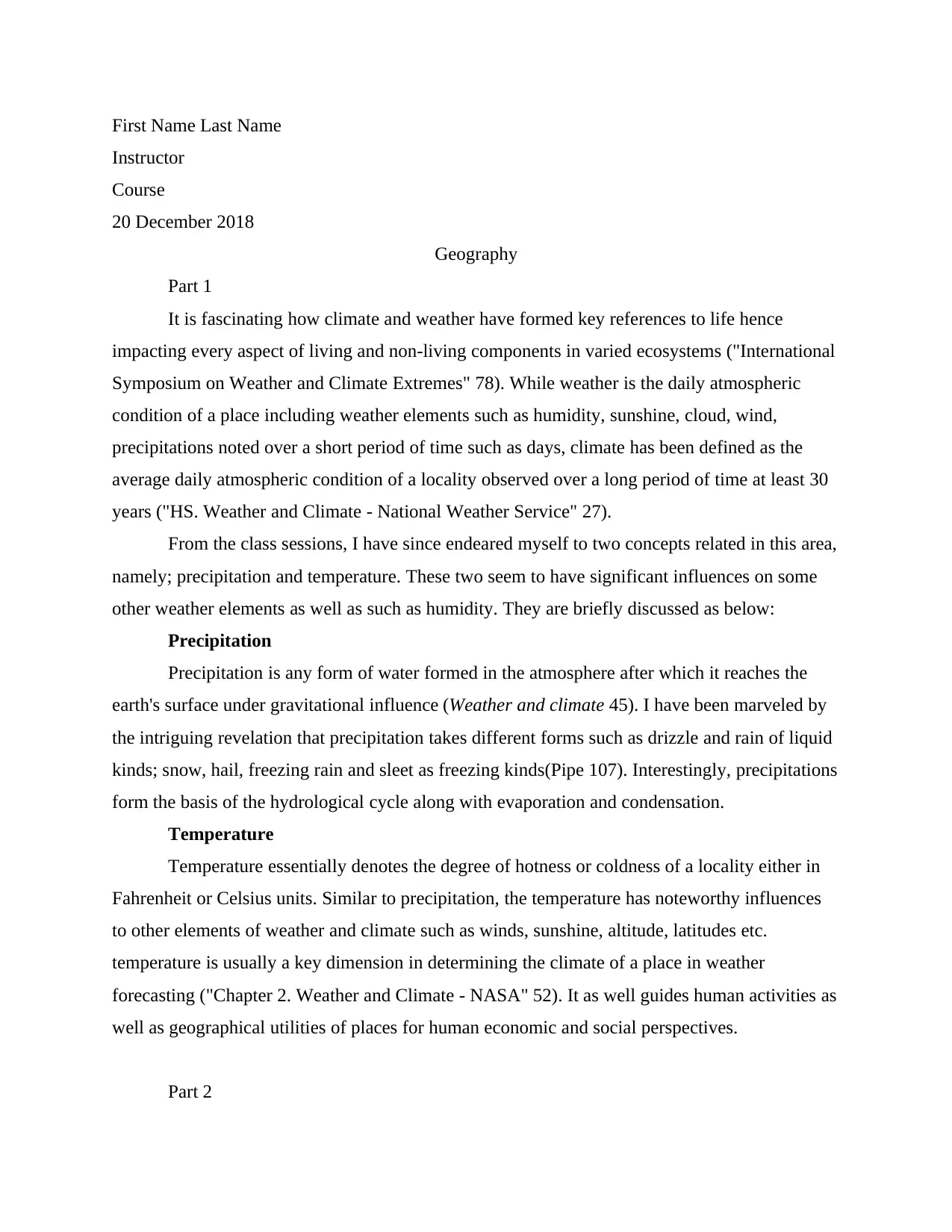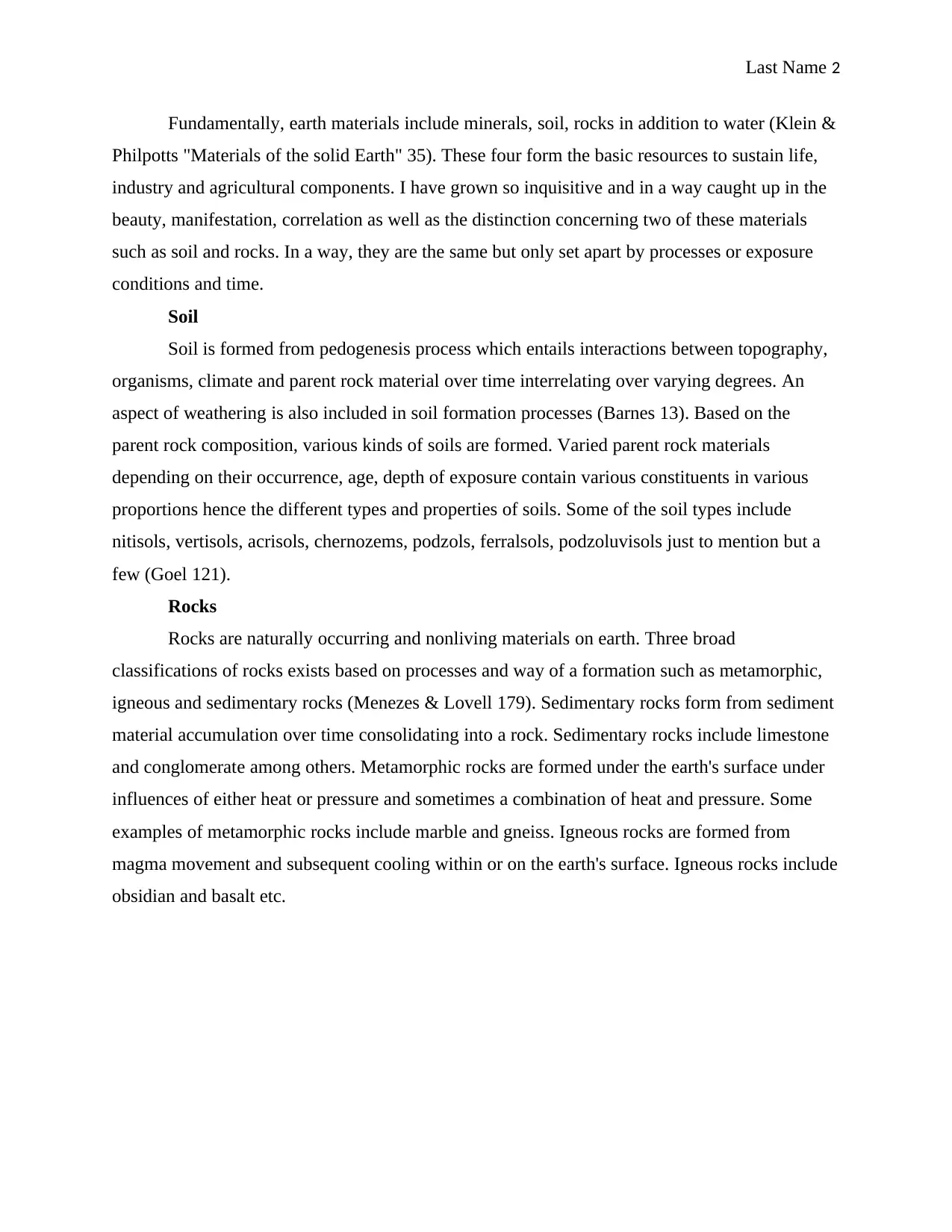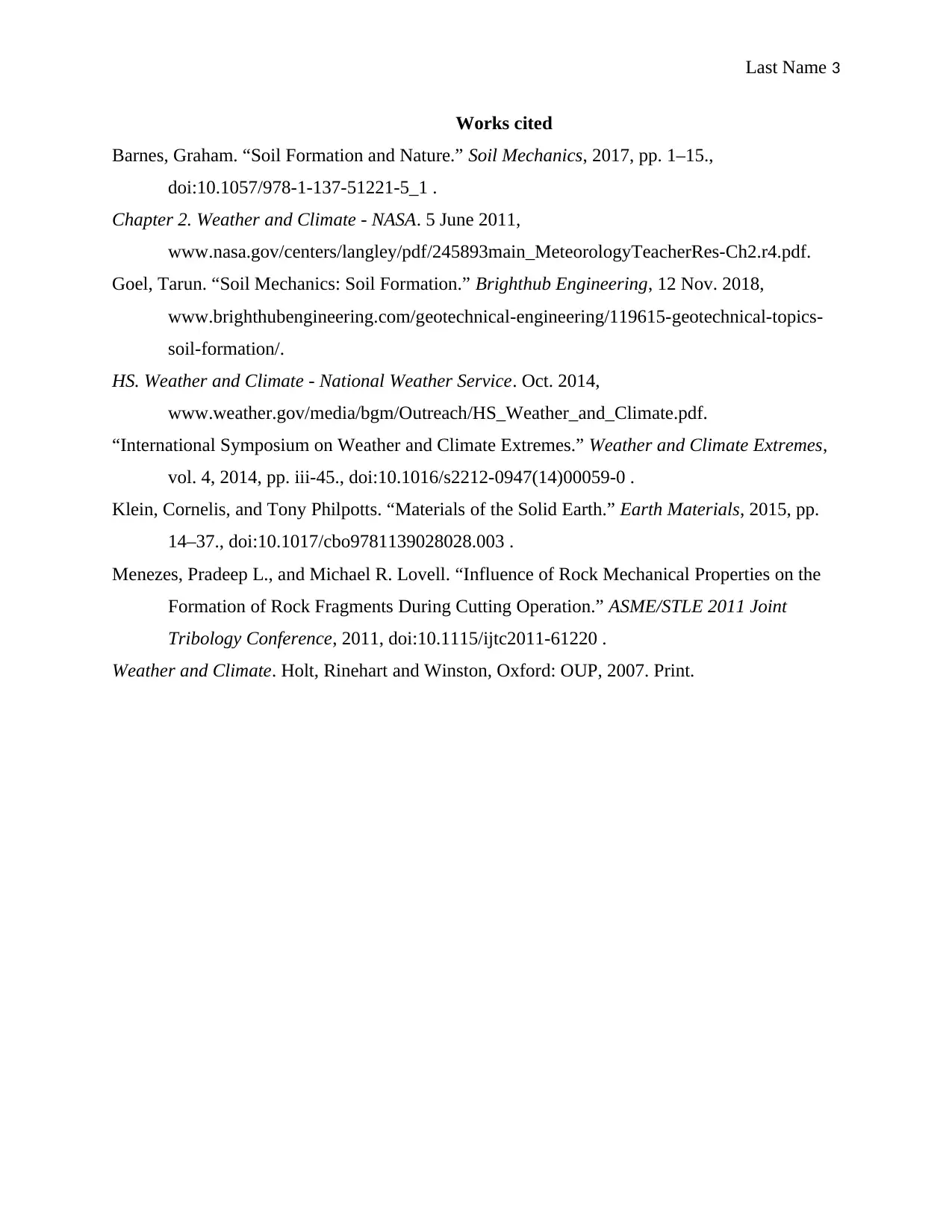Climate, Weather & Earth Materials: A Geography Course Assignment
VerifiedAdded on 2023/04/20
|3
|882
|433
Essay
AI Summary
This geography essay delves into the interconnectedness of climate, weather, and earth materials, highlighting the significance of precipitation and temperature as key climate elements. It further explores the formation and classification of earth materials such as soil and rocks, contrasting their origins and properties. The essay differentiates between soil formation through pedogenesis and rock formation via igneous, sedimentary, and metamorphic processes. Providing a comprehensive overview of these environmental science concepts, the document is intended to enhance understanding and is available on Desklib, a platform offering a wealth of study tools and solved assignments for students.

First Name Last Name
Instructor
Course
20 December 2018
Geography
Part 1
It is fascinating how climate and weather have formed key references to life hence
impacting every aspect of living and non-living components in varied ecosystems ("International
Symposium on Weather and Climate Extremes" 78). While weather is the daily atmospheric
condition of a place including weather elements such as humidity, sunshine, cloud, wind,
precipitations noted over a short period of time such as days, climate has been defined as the
average daily atmospheric condition of a locality observed over a long period of time at least 30
years ("HS. Weather and Climate - National Weather Service" 27).
From the class sessions, I have since endeared myself to two concepts related in this area,
namely; precipitation and temperature. These two seem to have significant influences on some
other weather elements as well as such as humidity. They are briefly discussed as below:
Precipitation
Precipitation is any form of water formed in the atmosphere after which it reaches the
earth's surface under gravitational influence (Weather and climate 45). I have been marveled by
the intriguing revelation that precipitation takes different forms such as drizzle and rain of liquid
kinds; snow, hail, freezing rain and sleet as freezing kinds(Pipe 107). Interestingly, precipitations
form the basis of the hydrological cycle along with evaporation and condensation.
Temperature
Temperature essentially denotes the degree of hotness or coldness of a locality either in
Fahrenheit or Celsius units. Similar to precipitation, the temperature has noteworthy influences
to other elements of weather and climate such as winds, sunshine, altitude, latitudes etc.
temperature is usually a key dimension in determining the climate of a place in weather
forecasting ("Chapter 2. Weather and Climate - NASA" 52). It as well guides human activities as
well as geographical utilities of places for human economic and social perspectives.
Part 2
Instructor
Course
20 December 2018
Geography
Part 1
It is fascinating how climate and weather have formed key references to life hence
impacting every aspect of living and non-living components in varied ecosystems ("International
Symposium on Weather and Climate Extremes" 78). While weather is the daily atmospheric
condition of a place including weather elements such as humidity, sunshine, cloud, wind,
precipitations noted over a short period of time such as days, climate has been defined as the
average daily atmospheric condition of a locality observed over a long period of time at least 30
years ("HS. Weather and Climate - National Weather Service" 27).
From the class sessions, I have since endeared myself to two concepts related in this area,
namely; precipitation and temperature. These two seem to have significant influences on some
other weather elements as well as such as humidity. They are briefly discussed as below:
Precipitation
Precipitation is any form of water formed in the atmosphere after which it reaches the
earth's surface under gravitational influence (Weather and climate 45). I have been marveled by
the intriguing revelation that precipitation takes different forms such as drizzle and rain of liquid
kinds; snow, hail, freezing rain and sleet as freezing kinds(Pipe 107). Interestingly, precipitations
form the basis of the hydrological cycle along with evaporation and condensation.
Temperature
Temperature essentially denotes the degree of hotness or coldness of a locality either in
Fahrenheit or Celsius units. Similar to precipitation, the temperature has noteworthy influences
to other elements of weather and climate such as winds, sunshine, altitude, latitudes etc.
temperature is usually a key dimension in determining the climate of a place in weather
forecasting ("Chapter 2. Weather and Climate - NASA" 52). It as well guides human activities as
well as geographical utilities of places for human economic and social perspectives.
Part 2
Paraphrase This Document
Need a fresh take? Get an instant paraphrase of this document with our AI Paraphraser

Last Name 2
Fundamentally, earth materials include minerals, soil, rocks in addition to water (Klein &
Philpotts "Materials of the solid Earth" 35). These four form the basic resources to sustain life,
industry and agricultural components. I have grown so inquisitive and in a way caught up in the
beauty, manifestation, correlation as well as the distinction concerning two of these materials
such as soil and rocks. In a way, they are the same but only set apart by processes or exposure
conditions and time.
Soil
Soil is formed from pedogenesis process which entails interactions between topography,
organisms, climate and parent rock material over time interrelating over varying degrees. An
aspect of weathering is also included in soil formation processes (Barnes 13). Based on the
parent rock composition, various kinds of soils are formed. Varied parent rock materials
depending on their occurrence, age, depth of exposure contain various constituents in various
proportions hence the different types and properties of soils. Some of the soil types include
nitisols, vertisols, acrisols, chernozems, podzols, ferralsols, podzoluvisols just to mention but a
few (Goel 121).
Rocks
Rocks are naturally occurring and nonliving materials on earth. Three broad
classifications of rocks exists based on processes and way of a formation such as metamorphic,
igneous and sedimentary rocks (Menezes & Lovell 179). Sedimentary rocks form from sediment
material accumulation over time consolidating into a rock. Sedimentary rocks include limestone
and conglomerate among others. Metamorphic rocks are formed under the earth's surface under
influences of either heat or pressure and sometimes a combination of heat and pressure. Some
examples of metamorphic rocks include marble and gneiss. Igneous rocks are formed from
magma movement and subsequent cooling within or on the earth's surface. Igneous rocks include
obsidian and basalt etc.
Fundamentally, earth materials include minerals, soil, rocks in addition to water (Klein &
Philpotts "Materials of the solid Earth" 35). These four form the basic resources to sustain life,
industry and agricultural components. I have grown so inquisitive and in a way caught up in the
beauty, manifestation, correlation as well as the distinction concerning two of these materials
such as soil and rocks. In a way, they are the same but only set apart by processes or exposure
conditions and time.
Soil
Soil is formed from pedogenesis process which entails interactions between topography,
organisms, climate and parent rock material over time interrelating over varying degrees. An
aspect of weathering is also included in soil formation processes (Barnes 13). Based on the
parent rock composition, various kinds of soils are formed. Varied parent rock materials
depending on their occurrence, age, depth of exposure contain various constituents in various
proportions hence the different types and properties of soils. Some of the soil types include
nitisols, vertisols, acrisols, chernozems, podzols, ferralsols, podzoluvisols just to mention but a
few (Goel 121).
Rocks
Rocks are naturally occurring and nonliving materials on earth. Three broad
classifications of rocks exists based on processes and way of a formation such as metamorphic,
igneous and sedimentary rocks (Menezes & Lovell 179). Sedimentary rocks form from sediment
material accumulation over time consolidating into a rock. Sedimentary rocks include limestone
and conglomerate among others. Metamorphic rocks are formed under the earth's surface under
influences of either heat or pressure and sometimes a combination of heat and pressure. Some
examples of metamorphic rocks include marble and gneiss. Igneous rocks are formed from
magma movement and subsequent cooling within or on the earth's surface. Igneous rocks include
obsidian and basalt etc.

Last Name 3
Works cited
Barnes, Graham. “Soil Formation and Nature.” Soil Mechanics, 2017, pp. 1–15.,
doi:10.1057/978-1-137-51221-5_1 .
Chapter 2. Weather and Climate - NASA. 5 June 2011,
www.nasa.gov/centers/langley/pdf/245893main_MeteorologyTeacherRes-Ch2.r4.pdf.
Goel, Tarun. “Soil Mechanics: Soil Formation.” Brighthub Engineering, 12 Nov. 2018,
www.brighthubengineering.com/geotechnical-engineering/119615-geotechnical-topics-
soil-formation/.
HS. Weather and Climate - National Weather Service. Oct. 2014,
www.weather.gov/media/bgm/Outreach/HS_Weather_and_Climate.pdf.
“International Symposium on Weather and Climate Extremes.” Weather and Climate Extremes,
vol. 4, 2014, pp. iii-45., doi:10.1016/s2212-0947(14)00059-0 .
Klein, Cornelis, and Tony Philpotts. “Materials of the Solid Earth.” Earth Materials, 2015, pp.
14–37., doi:10.1017/cbo9781139028028.003 .
Menezes, Pradeep L., and Michael R. Lovell. “Influence of Rock Mechanical Properties on the
Formation of Rock Fragments During Cutting Operation.” ASME/STLE 2011 Joint
Tribology Conference, 2011, doi:10.1115/ijtc2011-61220 .
Weather and Climate. Holt, Rinehart and Winston, Oxford: OUP, 2007. Print.
Works cited
Barnes, Graham. “Soil Formation and Nature.” Soil Mechanics, 2017, pp. 1–15.,
doi:10.1057/978-1-137-51221-5_1 .
Chapter 2. Weather and Climate - NASA. 5 June 2011,
www.nasa.gov/centers/langley/pdf/245893main_MeteorologyTeacherRes-Ch2.r4.pdf.
Goel, Tarun. “Soil Mechanics: Soil Formation.” Brighthub Engineering, 12 Nov. 2018,
www.brighthubengineering.com/geotechnical-engineering/119615-geotechnical-topics-
soil-formation/.
HS. Weather and Climate - National Weather Service. Oct. 2014,
www.weather.gov/media/bgm/Outreach/HS_Weather_and_Climate.pdf.
“International Symposium on Weather and Climate Extremes.” Weather and Climate Extremes,
vol. 4, 2014, pp. iii-45., doi:10.1016/s2212-0947(14)00059-0 .
Klein, Cornelis, and Tony Philpotts. “Materials of the Solid Earth.” Earth Materials, 2015, pp.
14–37., doi:10.1017/cbo9781139028028.003 .
Menezes, Pradeep L., and Michael R. Lovell. “Influence of Rock Mechanical Properties on the
Formation of Rock Fragments During Cutting Operation.” ASME/STLE 2011 Joint
Tribology Conference, 2011, doi:10.1115/ijtc2011-61220 .
Weather and Climate. Holt, Rinehart and Winston, Oxford: OUP, 2007. Print.
⊘ This is a preview!⊘
Do you want full access?
Subscribe today to unlock all pages.

Trusted by 1+ million students worldwide
1 out of 3
Related Documents
Your All-in-One AI-Powered Toolkit for Academic Success.
+13062052269
info@desklib.com
Available 24*7 on WhatsApp / Email
![[object Object]](/_next/static/media/star-bottom.7253800d.svg)
Unlock your academic potential
Copyright © 2020–2025 A2Z Services. All Rights Reserved. Developed and managed by ZUCOL.




